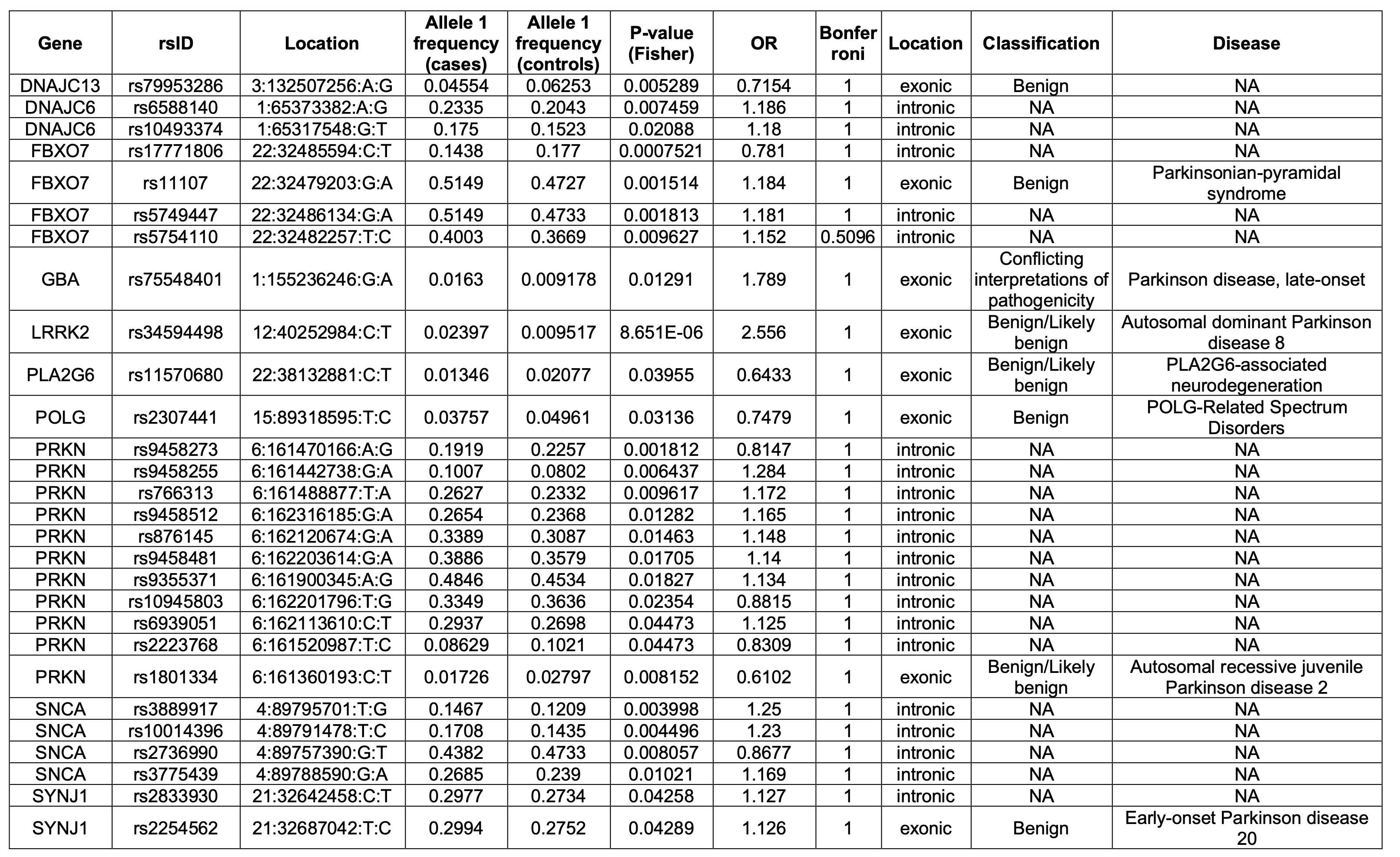Category: Parkinson's Disease: Genetics
Objective: To identify rare genetic variants in genes, previously associated with Parkinson’s disease (PD) within a population consisting of individuals with PD and unaffected controls from Kazakhstan.
Background: Across PD genomics, Central Asian and Transcaucasian (CAT) populations remains significantly underrepresented. To address this gap, the “Developing a Collaborative Parkinson’s Disease Biobank in Central Asia and Transcaucasia (CAT-PD)” Michael J. Fox Foundation (MJFF)-funded project was initiated in 2023.
Method: To enrich Kazakhstani CAT-PD genotyping array data from 1,258 cases and 518 controls (Illumina Neurobooster array, Global Parkinson’s Disease Genetics Program (GP2)), we added 1,904 Kazakhstani controls without PD genotyped on PsychChip array. Raw data was converted (GenomeStudio v2.0.5) to plink output and underwent standard quality control (QC). Variants from genomic regions previously linked to PD were extracted and annotated (Annovar). Association analysis was performed on unimputed data using Plink1.9.
Results: After merging array sets, 3,331 adult individuals (PD=1,043, controls=2,288, m/f=1,642/1,689) and 277,948 common variants remained. We identified 276 variants (90 exonic, of which 88 non-synonymous) within abovementioned genomic regions. Association tests were statistically significant in 28 variants [table1]. While none of them passed significance threshold after the Bonferroni correction, an exonic heterozygous GBA1 c.1223C>T (34 het. alleles, p=0.012, OR=1.79, CADD=21.3, GERP=0.4, HWE, p=1) variant passed significance level when testing GBA variants only [table2]. This variant with conflicting interpretations of pathogenicity was observed more frequently in cases (MAF case/control 0.016/0.009), while in gnomAD4.0 allele frequency was observed less (MAF=0.0069), with highest occurrence in Amish (MAF= 0.028) and Finnish (MAF= 0.01) ancestries. Interestingly, the GBA variant was in close proximity to the recently reported GBA variant [1]. The remaining variants were classified as benign. Additionally, we observed non-significant association for two pathogenic variants – GBA1 c.1226A>G and PRKN c.823C>T, and 15 exonic missense variants of uncertain significance.
Conclusion: We identified rare genetic variants linked to PD, including pathogenic and non-pathogenic variants, highlighting the importance of further investigation within CAT region.
Significant variants at PD-linked genomic regions
GBA variants within Kazakhstani CAT-PD cohort
References: [1] Rizig M, Bandres-Ciga S, Makarious MB, et al. Genome-wide Association Identifies Novel Etiological Insights Associated with Parkinson’s Disease in African and African Admixed Populations. Preprint. medRxiv. 2023;2023.05.05.23289529. Published 2023 May 7. doi:10.1101/2023.05.05.23289529
To cite this abstract in AMA style:
M. Isayan, N. Zharkinbekova, S. Abdraimova, CH. Shashkin, ZH. Myrzayev, V. Akhmetzhanov, A. Karimova, M. Ganieva, Z. Tavadyan, S. Khachatryan, M. Beridze, S. Sopromadze, I. Khatiashvilli, M. Kekenadze, K. Ceferov, V. Escott-Price, J. Hardy, H. Houlden, R. Kaiyrzhanov. Rare Variant Association Analysis in Kazakhstani Parkinson’s Disease Population: Preliminary Results from GP2 CAT-PD Study [abstract]. Mov Disord. 2024; 39 (suppl 1). https://www.mdsabstracts.org/abstract/rare-variant-association-analysis-in-kazakhstani-parkinsons-disease-population-preliminary-results-from-gp2-cat-pd-study/. Accessed July 15, 2025.« Back to 2024 International Congress
MDS Abstracts - https://www.mdsabstracts.org/abstract/rare-variant-association-analysis-in-kazakhstani-parkinsons-disease-population-preliminary-results-from-gp2-cat-pd-study/


